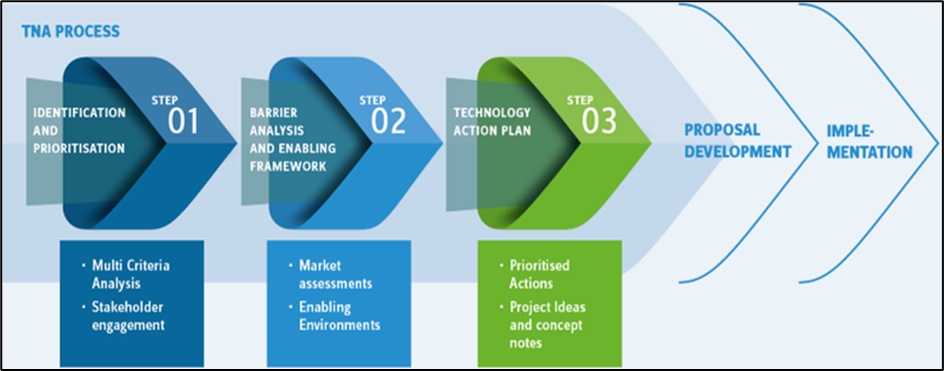Technology Needs Assessment
Pathways for climate tech implementation
Overview
What are the Technology Needs Assessments (TNAs)?
First considered under the UNFCCC in 2001 (Decision 4/CP.7), technology needs assessments (TNAs) have evolved into comprehensive, country-led, multi-stakeholder processes that result in the identification and prioritization of technologies needed for climate change adaptation and mitigation in different sectors of the economy. TNAs also identify barriers to the development, transfer and uptake of these technologies and ways to address technology needs and barriers, including through technology action plans (TAPs). Countries are increasingly using their TNAs and TAPs to inform the development and implementation of their Nationally Determined Contributions (NDCs) and long-term low greenhouse gas emission development strategies (LT-LEDS) under the Paris Agreement.
Watch this video to see how countries are benefiting from TNAs:
-
98
Number of developing countries with completed TNA
-
26
Number of developing countries currently undertaking a TNA
-
17
Number of developing countries that have completed a TNA
-
1839
Million USD in value of approved projects informed by TNAs
TNA Characteristics
Country-driven: TNAs are initiated, led, and owned by the country
Participatory: TNAs ensure the participation of stakeholders from government, civil society, academia and the private sector
Comprehensive: TNAs focus on one or more sectors, including both mitigation and adaptation technologies
Action-oriented: TNAs result in TAPs and project concept notes that provide roadmaps for concrete actions, including project development
TNA Process

Photo credit: UNEP Copenhagen Climate Centre
Step 1: Identifying and Prioritizing Technologies
This first step involves a comprehensive assessment of available technologies, technology needs and opportunities across different sectors. Key stakeholders are involved in the process to identify technologies with the highest potential to mitigate climate change and adapt to its impacts. Prioritization takes into account not only environmental benefits but also economic viability, social acceptability, and alignment with national development goals.
Step 2: Analyzing Barriers and Building an Enabling Environment
Once technologies have been prioritized, the TNA process identifies the challenges to their implementation. This includes identifying barriers such as inadequate funding, lack of capacity, policy gaps, and market failures. Solutions are then formulated to address these barriers, creating an enabling environment for technology adoption.
Step 3: Developing Technology Action Plans
The final step is to translate the prioritized technologies into concrete technology action plans (TAPs), which outline the specific actions required for technology implementations, including: roles and responsibilities (government, private sector, etc.); resources required (financial, human, etc.); timeframes; funding opportunities and mechanisms; and monitoring and evaluation procedures. TAPs are developed for sectors of an economy or for several or individual technologies.
Developing countries interested in undertaking a TNA are invited to contact the UNEP Copenhagen Climate Centre at the following link: https://tech-action.unepccc.org/contacts
 |  |
